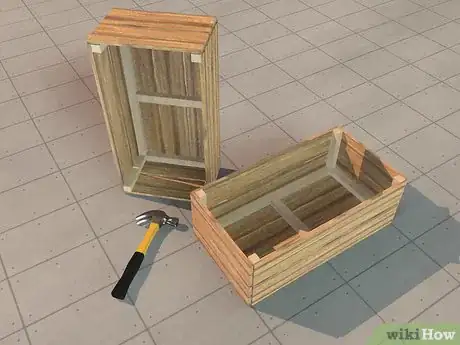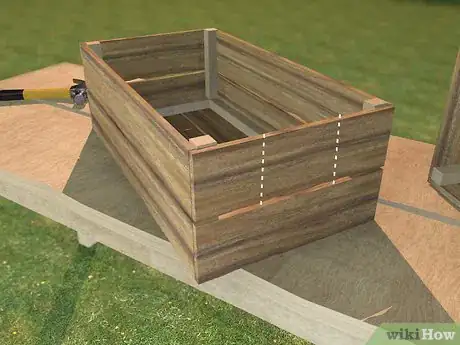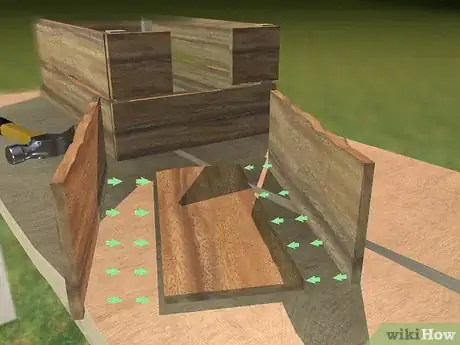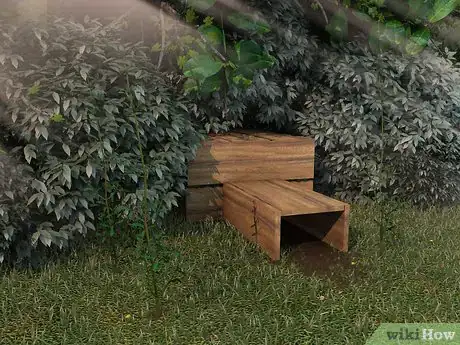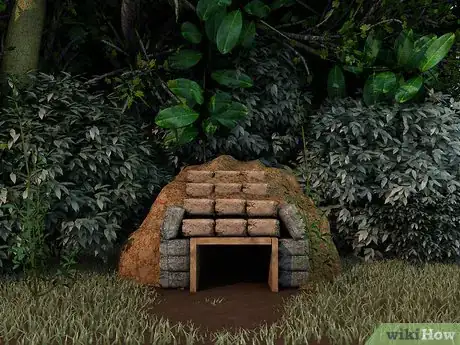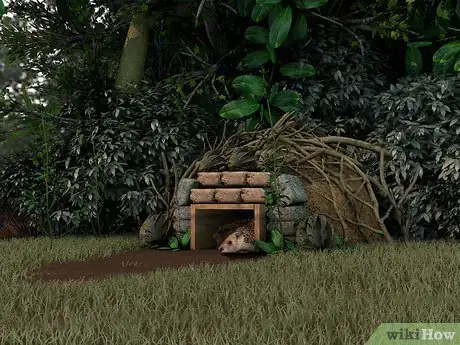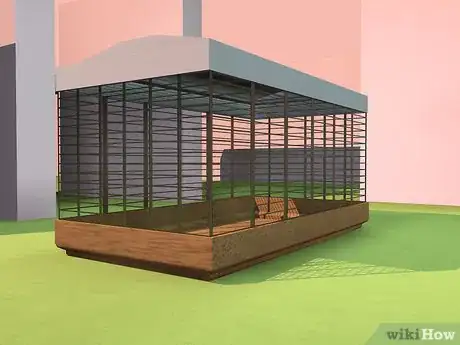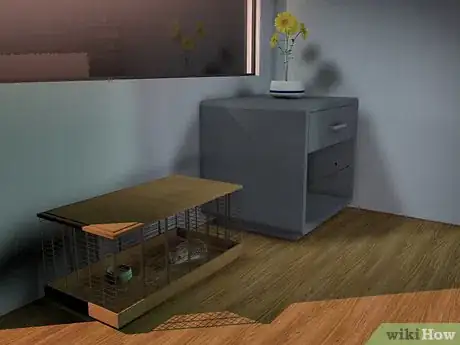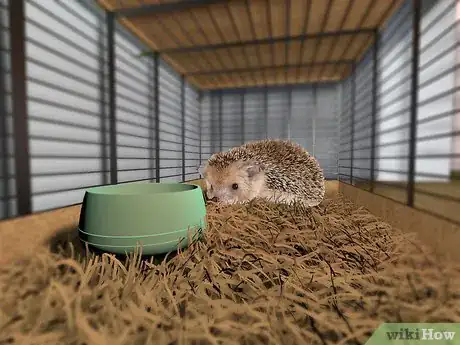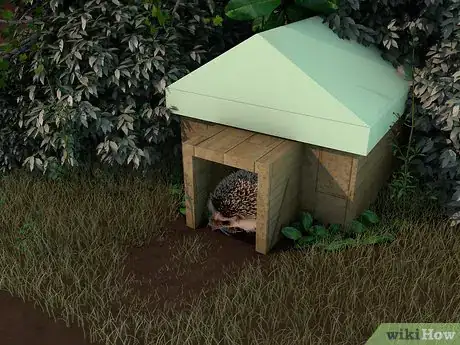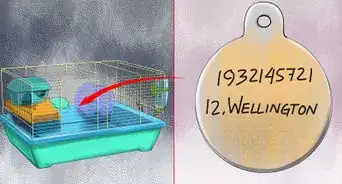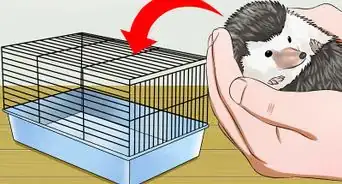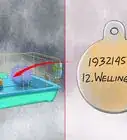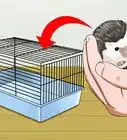This article was co-authored by Alisa Rassin. Alias Rassin is an Exotics Veterinarian and the Owner of The Exotic Animal Hospital of Pennsylvania in Lansdowne, Pennsylvania. With over a decade of experience, she specializes in treating reptiles, birds, and small mammals. She holds a Veterinariae Medicinae Doctoris from The University of Pennsylvania and a BS in Veterinary Biomedical and Clinical Sciences from Penn State University. She was also certified by the Royal College of Veterinary Surgeons.
There are 8 references cited in this article, which can be found at the bottom of the page.
wikiHow marks an article as reader-approved once it receives enough positive feedback. In this case, several readers have written to tell us that this article was helpful to them, earning it our reader-approved status.
This article has been viewed 77,022 times.
Whether you have a hedgehog in your garden or a pet hedgehog indoors, it requires safe and cozy living quarters. Build a simple enclosure using a wooden crate or box to protect wild hedgehogs from the elements and predator animals. To set up a hedgehog home indoors, select an appropriate enclosure and fill it with the items that your hedgehog needs.
Steps
Building an Outdoor Hedgehog Home
-
1Get a 2 by 2 ft (0.61 by 0.61 m) or larger wooden crate or box. Reusing an old wooden box or crate is a great way to upcycle it and it will make giving your garden hedgehog a home quick and easy. You may have a wooden crate at home that you don’t need. If not, check at your local grocery store to see if they have an empty wooden crate you could have.[1]
- Make sure that the crate or box has openings between the slats. This helps to ensure that the hedgehog’s home will be well-ventilated.
Tip: If you absolutely cannot find a wooden box or crate, then you can build a crate using reclaimed wood. However, avoid using wood that has been pre-treated since this can be hazardous to the hedgehog. If possible, go with Douglas-fir, red cedar, or larch wood.[2]
-
2Cut a 17 by 17 cm (6.7 by 6.7 in) opening in the wooden crate or box. Use a tape measure or ruler and pencil to find these dimensions. Then, mark the box with 2 lines to indicate where the opening will go. Position the opening at about the center of the top slat (the slat closest to the box’s opening). Then, use a hand saw to cut through the slat and create the opening.[3]
- You should only have to cut through 1 of the slats on the crate to make this size opening.
- Place the box on a sturdy flat surface before you begin cutting.
Advertisement -
3Nail together three 17 by 30 cm (6.7 by 11.8 in) pieces of wood. You can use scrap wood or new wood cut to these dimensions. Place 2 of the wood pieces on their sides and 1 piece on top of these 2 so that the pieces form a tunnel. Hammer 1 nail through each corner of the top slat to secure the tunnel.[4]
- If you do not want to create a wooden tunnel, you can also use bricks to form an archway at the opening of the hedgehog house. After you put the house on the ground, place 2 bricks on their sides jutting out from the opening. Then, stack 3 bricks side-by-side and perpendicular to these 2 bricks to form a tunnel.
- Do not create a hedgehog house without a tunnel or archway! Not including a tunnel or archway will make it easy for predator animals to reach into the house and pull out hedgehogs.
-
4Place the box upside down in a cool, shady spot in your yard. Hedgehogs like shady spots, such as under bushes and trees. You could also position the hedgehog house behind a shed or near a fence in a quiet corner of your garden.[5]
- Avoid placing the box in a high-traffic area, or near where pets frequent in your garden. Try to give the hedgehogs some privacy.
-
5Place a few bricks, rocks, or logs on the house to weigh it down. The box may flip over if a strong gust of wind hits it. Keep it in place by putting a few heavy items on top of it, such as a few bricks, rocks, or logs. You can also line the edges of the box with heavy items for extra protection against predators.[6]
- Make sure that you do not put more weight on the box than it can bear. A few bricks, rocks, or small logs should be plenty to keep it in place.
-
6Surround the crate with leaves, sticks, and hay. Hedgehogs like to fill their homes with their own found materials, so do not put anything into the box for them. Leave it empty, but put nesting materials around the box for them to use.[7]
- Try putting your garden trimmings next to the box, such as branches and twigs from bushes you’ve pruned, leaves you’ve raked up, and other items that might make good nesting material for the hedgehogs.
Creating an Indoor Home for Your Hedgehog
-
1Choose a 4 by 2 ft (1.22 by 0.61 m), well-ventilated, solid-bottomed cage. Hedgehogs require lots of room to run and play, so they need big enclosures. The minimum size for a hedgehog is 4 by 2 ft (1.22 by 0.61 m), and larger is always better for them! Choose an enclosure that allows air to flow freely through it, such as a cage with wire sides. However, avoid wire-bottomed cages since these may injure your hedgehog’s feet.[8]
- You may also want to look for a cage that has multiple levels so your hedgehog can climb. This is not a necessity, but it would provide your hedgehog with extra room to explore.
-
2Position the cage away from drafts and direct sunlight. Hedgehogs like to be in a comfortably cool, shady environment, so avoid putting your hedgehog’s cage anywhere with an extreme temperature or too much sunlight. Try to keep the ambient temperature in your hedgehog’s space around 72 °F (22 °C). Don’t place the enclosure in a sunny spot or anywhere that will get too hot or too cold.[9]
- For example, you may want to place your hedgehog’s enclosure next to an interior wall, rather than next to a window or drafty doorway.
-
3Line the bottom of the cage with shredded paper or hay bedding. Hedgehogs like to build little nests, and shredded newspaper or hay bedding is great for that. Place about 1 in (2.5 cm) of bedding in the bottom of your hedgehog’s enclosure.[10]
- Shredded newspaper bedding is the easiest to clean. You can simply scoop out the feces and urine soaked bedding daily.
- Avoid wood chips as bedding since this may be harmful to your hedgehog.
Tip: Flannel or cotton cloth liners are also an option for bedding if you want something reusable. The downside of this option is that your hedgehog won’t be able to burrow and you will also need to change the cloth liner daily to wash away the urine and feces.[11]
-
4Give your hedgehog a hiding spot. You can purchase hiding spots for your hedgehog in a pet store, such as little igloos, hollow logs, and small wooden boxes. Make sure to place at least 1 of these into your hedgehog’s enclosure so that it can go into the hiding spot when it wants to sleep or relax.[12]
- Having a hiding spot in your hedgehog’s enclosure will also help to increase its sense of security since hedgehogs retreat into their holes when they feel threatened.
-
5Provide food and water for your hedgehog. Hedgehogs can eat low-fat dry cat food to meet most of their nutritional needs. Fill a small ceramic dish with food and allow the hedgehog to free-feed. You will also need to include a water bottle or ceramic dish filled with water.[13]
- Hedgehogs also enjoy treats, such as fresh fruit or veggie slices, crickets, or dried mealworms. Try putting a different treat into your hedgehog’s enclosure daily.
-
6Provide toys and other enrichment items. Hedgehogs are playful creatures, so giving it some toys is a great way to help make it feel at home. Provide your hedgehog with an exercise wheel that is 12 in (30 cm) in diameter. Tunnels, ramps, balls, and bells also make great toys for hedgehogs.[14]
- Check your local pet store to find toys and other enrichment items that are meant for hedgehogs.
Expert Q&A
-
QuestionCan a hedgehog be kept in a glass tank?
 Alisa RassinAlias Rassin is an Exotics Veterinarian and the Owner of The Exotic Animal Hospital of Pennsylvania in Lansdowne, Pennsylvania. With over a decade of experience, she specializes in treating reptiles, birds, and small mammals. She holds a Veterinariae Medicinae Doctoris from The University of Pennsylvania and a BS in Veterinary Biomedical and Clinical Sciences from Penn State University. She was also certified by the Royal College of Veterinary Surgeons.
Alisa RassinAlias Rassin is an Exotics Veterinarian and the Owner of The Exotic Animal Hospital of Pennsylvania in Lansdowne, Pennsylvania. With over a decade of experience, she specializes in treating reptiles, birds, and small mammals. She holds a Veterinariae Medicinae Doctoris from The University of Pennsylvania and a BS in Veterinary Biomedical and Clinical Sciences from Penn State University. She was also certified by the Royal College of Veterinary Surgeons.
Exotics Veterinarian That's not a good idea! Glass tanks can build a lot of ammonia from the feces at the bottom of the cage. This makes the hedgehog's living space smell really terrible—so, hedgehogs don't like living in a glass container. A wooden enclosure is typically the best option, since plastic can melt and metal can get overheated.
That's not a good idea! Glass tanks can build a lot of ammonia from the feces at the bottom of the cage. This makes the hedgehog's living space smell really terrible—so, hedgehogs don't like living in a glass container. A wooden enclosure is typically the best option, since plastic can melt and metal can get overheated. -
QuestionCan I use a dog cage for a hedgehog?
 Community AnswerYes, but it must have a solid bottom as their legs are very fragile. If it isn't a smooth flat surface it might break its legs.
Community AnswerYes, but it must have a solid bottom as their legs are very fragile. If it isn't a smooth flat surface it might break its legs. -
QuestionDo I use litter in the litter box?
 Community AnswerYes, you do. Cat litter works just fine, but use a good-quality brand for your little guy.
Community AnswerYes, you do. Cat litter works just fine, but use a good-quality brand for your little guy.
Things You'll Need
Building an Outdoor Hedgehog Home
- 2 by 2 ft (0.61 by 0.61 m) or larger wooden crate or slatted box
- Ruler
- Pen or pencil
- Hand saw
- Hammer and nails
- Three 17 by 30 cm (6.7 by 11.8 in) pieces of wood or 5 bricks
- A few bricks, rocks, or logs
- Leaves, sticks, and hay
Creating an Indoor Home for Your Hedgehog
- 4 by 2 ft (1.22 by 0.61 m) or larger, well-ventilated, solid-bottomed cage
- Shredded newspaper or hay bedding
- Hiding spot
- Dry cat food
- Ceramic dish for food
- Water bottle or ceramic dish filled with water
- 12 in (30 cm) exercise wheel
- Ramps, tunnels, balls, and bells
Expert Interview

Thanks for reading our article! If you'd like to learn more about building a home for a hedgehog, check out our in-depth interview with Alisa Rassin.
References
- ↑ https://www.youtube.com/watch?v=cSJjDdW05io&feature=youtu.be&t=46
- ↑ https://www.hedgehogstreet.org/help-hedgehogs/hedgehog-homes/
- ↑ https://www.wildlifetrusts.org/actions/how-build-hedgehog-home
- ↑ https://www.wildlifetrusts.org/actions/how-build-hedgehog-home
- ↑ https://www.youtube.com/watch?v=cSJjDdW05io&feature=youtu.be&t=135
- ↑ https://www.youtube.com/watch?v=cSJjDdW05io&feature=youtu.be&t=145
- ↑ https://www.youtube.com/watch?v=cSJjDdW05io&feature=youtu.be&t=152
- ↑ http://hedgehogclub.com/care.html#housing
- ↑ http://hedgehogclub.com/care.html#housing
